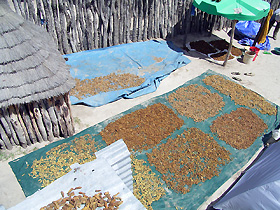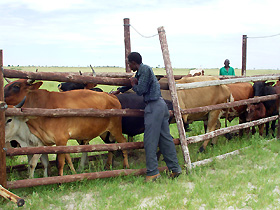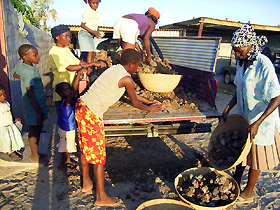(3)
I carried out fieldwork in the Uukwangula village of the Oshana Region in Northern Namibia from February to May 2006. In recent years, some Ovambo people have established individual, fenced grazing grounds for cattle in places far removed from their village. These grounds are called “cattle posts” in English, or ohambo in the local language. The owners of the cattle posts use this land not only for grazing, but also for gathering natural resources. In this fieldwork, I focused my research on natural resource uses at the cattle posts and the reasons for its increase in recent years.
In the village of Uukwangula, 8 out of 30 households own cattle posts. The villagers employ a grazing system of seasonal migration, in which they move cattle southward from the village and set up temporary camps for grazing during the dry season. However, since 1982, some households have built fences around their grazing grounds, employed cowboys, and begun to pasture their livestock year-round. Because it costs so much to build and maintain cattle posts, most owners were or still are cash earners in their villages. The running costs of keeping cattle posts include: payment of the village head for the land, salary for the cowboys, and the transportation of cattle from village to cattle post.
Cattle posts are also used for gathering such natural resources as edible insects, grasses for building materials, firewood, and manure. Recently, gathering has become more important because natural resources around their village have reduced. The owners, or the cowboys who stay at the cattle post, gather these natural resources and use them not only for their own households, but also as gifts for their relatives and neighbors. This allows landowners to share their natural resources with those who do not own cattle posts and are therefore unable to obtain them. However, the increasing number of cattle posts might point to an overuse of these resources, resulting in the deterioration of the natural environment. It will be important to estimate the numbers of rare wild animals and plants for the future.



 21st Century COE Program
-Aiming for COE of Integrated Area Studies-
21st Century COE Program
-Aiming for COE of Integrated Area Studies-